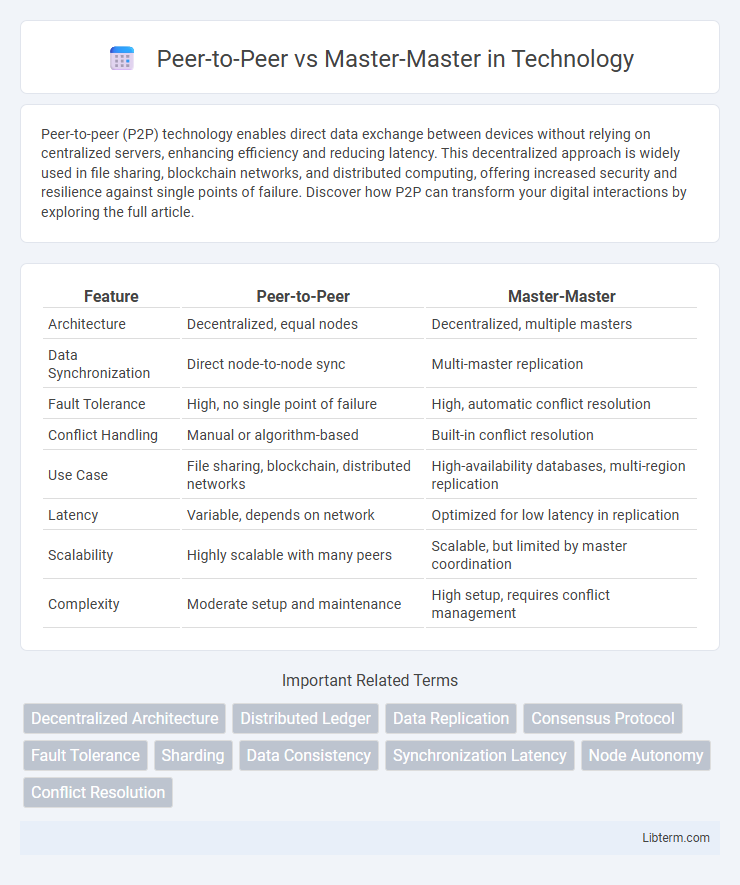Peer-to-peer (P2P) technology enables direct data exchange between devices without relying on centralized servers, enhancing efficiency and reducing latency. This decentralized approach is widely used in file sharing, blockchain networks, and distributed computing, offering increased security and resilience against single points of failure. Discover how P2P can transform your digital interactions by exploring the full article.
Table of Comparison
| Feature | Peer-to-Peer | Master-Master |
|---|---|---|
| Architecture | Decentralized, equal nodes | Decentralized, multiple masters |
| Data Synchronization | Direct node-to-node sync | Multi-master replication |
| Fault Tolerance | High, no single point of failure | High, automatic conflict resolution |
| Conflict Handling | Manual or algorithm-based | Built-in conflict resolution |
| Use Case | File sharing, blockchain, distributed networks | High-availability databases, multi-region replication |
| Latency | Variable, depends on network | Optimized for low latency in replication |
| Scalability | Highly scalable with many peers | Scalable, but limited by master coordination |
| Complexity | Moderate setup and maintenance | High setup, requires conflict management |
Introduction to Database Replication Topologies
Peer-to-Peer and Master-Master are prominent database replication topologies designed to enhance data availability and fault tolerance. Peer-to-Peer replication distributes data evenly across multiple nodes, allowing each peer to act as both a supplier and consumer of data, which improves scalability and load balancing. Master-Master replication involves two or more master nodes that handle read and write operations simultaneously, providing high availability and conflict resolution mechanisms for consistent data synchronization.
What is Peer-to-Peer Replication?
Peer-to-Peer replication is a database replication method where each node acts as both a supplier and consumer of data, enabling direct data exchange between peers without a central master node. This decentralized architecture enhances data availability and load distribution by synchronizing changes across all participating nodes independently. It contrasts with Master-Master replication by emphasizing equal roles for all nodes, reducing single points of failure and improving system resilience in distributed environments.
Understanding Master-Master Replication
Master-Master replication involves multiple database servers simultaneously acting as both masters and slaves, enabling bidirectional data synchronization and high availability across all nodes. This setup ensures that changes made on any node are propagated throughout the cluster, minimizing downtime and supporting load balancing for write operations. Understanding Master-Master replication requires recognizing its complexity in conflict resolution and the necessity of ensuring data consistency across distributed systems.
Core Differences Between Peer-to-Peer and Master-Master
Peer-to-Peer replication involves nodes that act as equals, each capable of sending and receiving updates independently, promoting a decentralized data synchronization model often used for multi-directional replication. Master-Master replication features multiple master nodes that independently handle read and write operations, requiring conflict resolution mechanisms to maintain consistency across nodes. Core differences include the level of node equality, conflict handling strategies, and use case suitability, with Peer-to-Peer emphasizing equal node roles and Master-Master prioritizing concurrent data modification with conflict detection.
Data Consistency and Conflict Resolution
Peer-to-Peer and Master-Master replication architectures both aim to enhance data availability and redundancy but differ significantly in data consistency and conflict resolution mechanisms. Peer-to-Peer systems often face challenges in maintaining strong consistency due to concurrent updates across nodes, requiring sophisticated conflict detection and resolution strategies such as vector clocks or conflict-free replicated data types (CRDTs). Master-Master replication enables bidirectional data synchronization with conflict resolution typically managed through predefined rules like last-write-wins or application-specific merge functions to ensure eventual consistency.
Performance and Scalability Considerations
Peer-to-Peer replication offers balanced load distribution and high availability, improving scalability by enabling multiple nodes to process transactions simultaneously, but it may incur increased conflict resolution overhead. Master-Master replication enhances write performance by allowing concurrent updates on multiple masters, yet it demands robust conflict detection mechanisms and might face latency issues during synchronization across distributed nodes. Performance in both models depends on workload patterns, network latency, and the efficiency of conflict handling, with Peer-to-Peer better suited for read-heavy applications and Master-Master optimized for write-intensive environments requiring strong data consistency.
Use Cases for Peer-to-Peer Replication
Peer-to-peer replication excels in distributed systems requiring high availability and fault tolerance, such as blockchain networks and real-time collaboration applications. Its architecture allows multiple nodes to act as equals, supporting scalability and decentralized data consistency without a single point of failure. Use cases include content delivery networks (CDNs), distributed databases, and multi-site data synchronization where latency and seamless data updates are critical.
When to Choose Master-Master Replication
Master-Master replication is ideal for distributed database systems requiring high availability and real-time data synchronization across multiple nodes, especially in write-intensive environments. It ensures conflict resolution mechanisms and data consistency, making it suitable for businesses with geographically dispersed teams or applications demanding continuous uptime. Choose Master-Master replication when seamless bidirectional data replication and fault tolerance are critical to operational success.
Challenges and Best Practices
Peer-to-peer replication faces challenges such as conflict resolution due to simultaneous data changes and higher complexity in synchronization management. Master-master replication requires robust conflict detection and resolution strategies to prevent data inconsistencies and maintain system availability. Best practices include implementing version control, using consensus algorithms like Paxos or Raft, and ensuring automated monitoring for error detection and rollback mechanisms to maintain data integrity across nodes.
Conclusion: Selecting the Right Replication Strategy
Choosing between Peer-to-Peer and Master-Master replication hinges on the specific requirements for data consistency, fault tolerance, and conflict resolution in your distributed database environment. Peer-to-Peer replication excels in scenarios demanding high availability and load balancing across multiple nodes without a single point of failure. Master-Master replication is ideal for applications necessitating active-active synchronization with immediate conflict detection and resolution to maintain data integrity.
Peer-to-Peer Infographic

 libterm.com
libterm.com